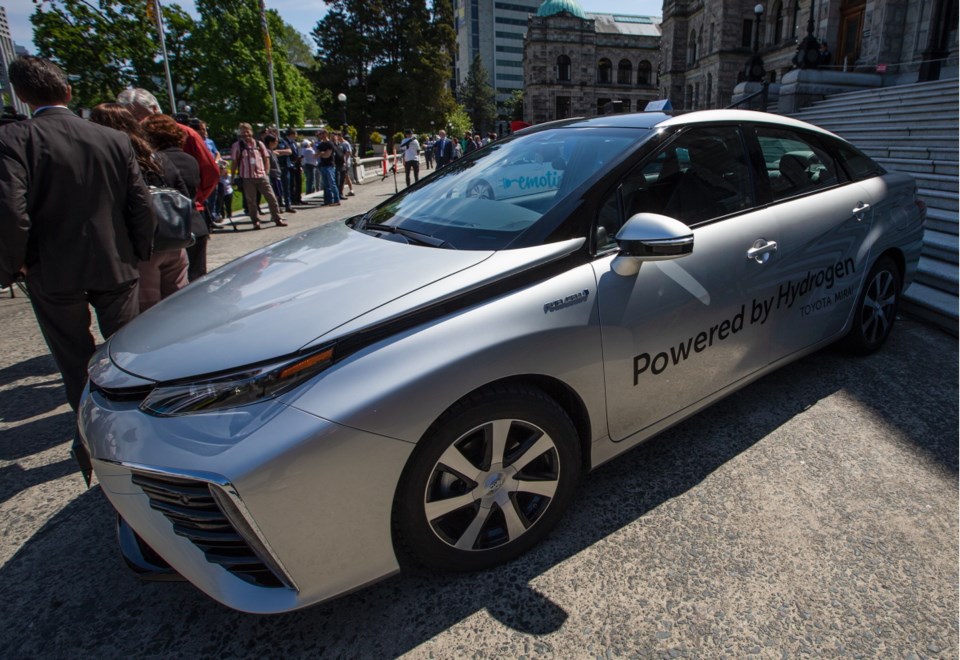Six automobile manufacturers are betting that battery-powered electric vehicles are just a phase, and that the cleanest, greenest car in your future will be a hydrogen-powered fuel-cell electric vehicle.
BMW, Honda, Hyundai, Kia, Mercedes-Benz and Toyota are actively developing the concept, which sees pure water vapour as the only exhaust emission.
I drove a Toyota Mirai, one of the first such vehicles to be sold commercially. First available in 2015, there are now more than 5,300 worldwide — but none in sa���ʴ�ý.
That will change late this year as Toyota initially launches the car in Quebec. This year, the government of Quebec took a leap of faith and ordered 50 of the cars for its fleet.
sa���ʴ�ý has been at the forefront of the technology, with Ballard Research of Vancouver founded in 1979 to develop hydrogen fuel-cell applications. In 2017, the company claimed its fuel-cell powered buses had logged more than 10 million kilometres of service.
Fuel cells generate power through an electrochemical process (which takes place in the fuel-cell stack) where hydrogen bonds with oxygen.
In a fuel-cell vehicle, the oxygen is taken in from the atmosphere and the hydrogen gas is carried onboard in two high-pressure (10,000 psi) tanks.
This process produces electricity that charges a battery. There is no combustion involved, and the only exhaust emission is pure water.
A FCEV has a range similar to gasoline-powered vehicles — about 550 kilometres for the Mirai — because the amount of energy stored on-board is similar.
Filling up is similar as well, with Toyota claiming it will take only five minutes to fill the five-kilogram tanks.
But the greatest limitation to more widespread adoption is infrastructure. There simply aren’t many hydrogen filling stations in sa���ʴ�ý — there is only one in British Columbia, which is located in Surrey and operated by sa���ʴ�ý Hydro.
The second limitation is cost. In the United States, where the Mirai is available, the car has a list price of more than $75,000 US.
The cost of running a hydrogen-powered vehicle is also unknown at this point: What will be the cost of a quantity of hydrogen? For that reason, Toyota USA credits buyers with free fuel for three years, or $15,000, whichever comes first.
The last issue revolves around the production of hydrogen.
Although hydrogen is the most abundant chemical element in the universe, getting it separated from other elements, then pressurized and stuffed it into your fuel tank, is not simple.
The most common process is called natural gas reforming (or steam methane reforming because it uses high-temperature steam). It can also be produced using electricity, through electrolysis of water, but that is more costly.
The Mirai is a four-passenger mid-sized sedan, about the same size of a Toyota Camry or Honda Clarity. The cabin is not terribly high-tech, with screens, gauges and features common to what you might expect in a Prius, with the same two-tiered dash and electronic shifter.
The front occupants sit atop the fuel-cell stack, and one of the two hydrogen tanks can be found under the butts of the rear passengers.
An electric motor is found under the hood, and a 1.6 kWh nickel-metal hydride battery (about the same size as found the in the Camry Hybrid) sits above the second hydrogen tank and behind the rear seat.
The Mirai drives and sounds like a typical electric car, with a gentle whine on acceleration. The AC motor produces 154 horsepower and 247 foot-pounds of torque.
My ride-and-drive did not allow time for a highway loop.
If you are eager to help reduce greenhouse gas emissions and affect meaningfully address climate change, a zero-emission vehicle could be in your future. Up till now, that meant an electric vehicle. But the Mirai (which translates to “the future” in Japanese) might just be another viable solution.
THE SPEC SHEET
Type: Mid-sized four-door sedan, front-engine, front-wheel-drive
Engine: (Fuel Cell) 114 kW
Electric motor: 154 hp and 247 lb.-ft. of torque
Battery: 1.6 kWh nickel-metal hydride
Transmission: One speed
Dimensions (mm): Length, 4,890; width, 1,815; height, 1,535; wheelbase, 2,780
Curb weight (kg): 1,850
Price: (Est.) $75,000
Options: Nil
Tires: 215/55 R 17 on alloy wheels
Fuel type: Hydrogen
Fuel economy (L/100km): (Est.) 3.6 litre-equivilent combined



